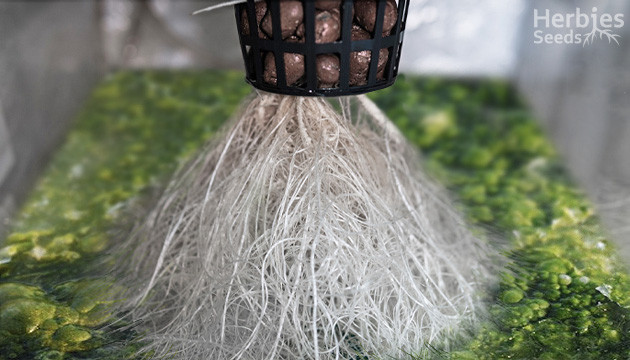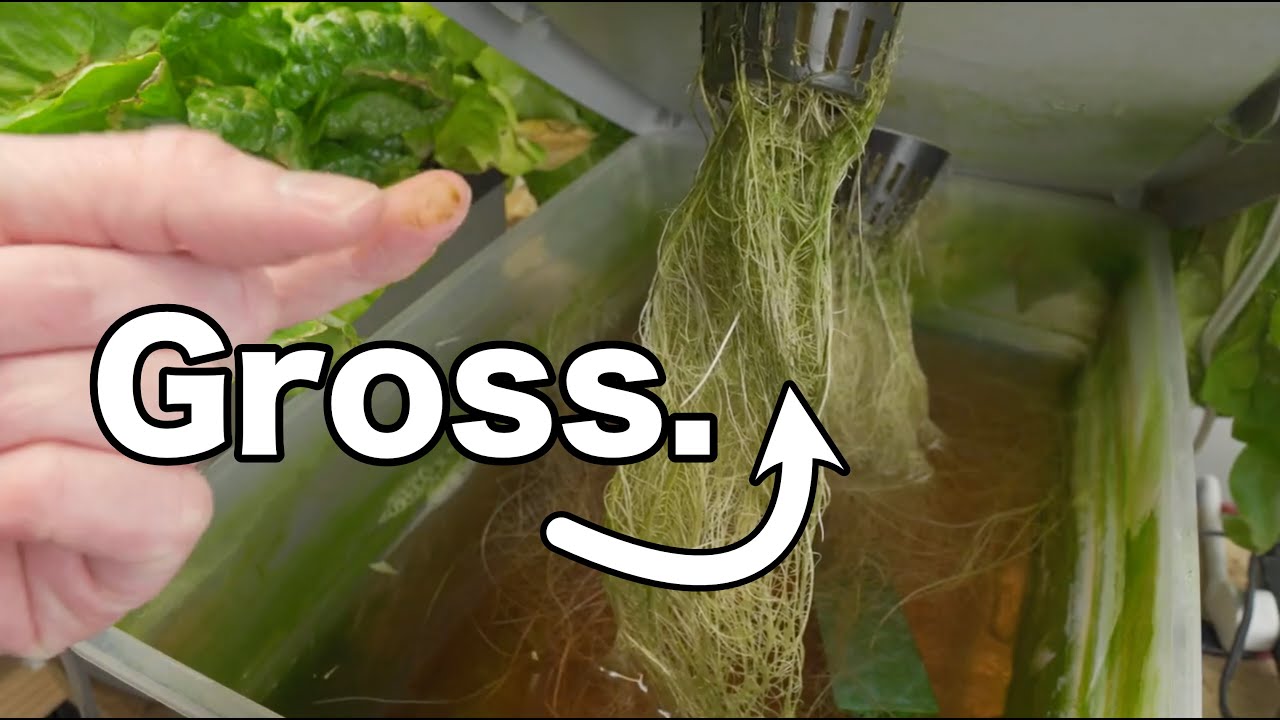To avoid algae in hydroponics, maintain proper water and nutrient levels and ensure good air circulation in the growing environment. Algae growth can be a common problem in hydroponic systems due to excess nutrients and insufficient oxygen levels in the water.
Algae growth can be a persistent and frustrating issue for hydroponic growers. It not only affects the health and growth of plants but also hampers the overall productivity of the system. Understanding the causes of algae growth and implementing preventive measures is crucial for maintaining a healthy and successful hydroponic setup.
This article will provide valuable insights into how to avoid algae in hydroponics by focusing on controlling water and nutrient levels, improving air circulation, and adopting proper maintenance practices. By following these guidelines, growers can effectively minimize algae growth and ensure optimal conditions for their hydroponic plants.

Credit: herbiesheadshop.com
Understanding The Algae Problem In Hydroponics
Algae can be a persistent problem in hydroponic systems. Understanding what algae is and why it poses a challenge is crucial for successful hydroponic gardening. Algae are tiny organisms that thrive in water, particularly when exposed to sunlight. They can quickly multiply and form a greenish film, clogging the system and depriving plants of essential nutrients.
The presence of algae can negatively impact the pH balance of the nutrient solution and create competition for resources between the algae and the plants. This competition can lead to poor plant growth and reduced yields. Algae can also obstruct air and light circulation, hindering the overall health of the hydroponic system. Regular maintenance and preventive measures are key to keeping algae at bay in hydroponics. Consistently monitoring and adjusting the nutrient solution, employing proper sterilization techniques, and using light-blocking materials can help prevent the growth of algae in hydroponic setups.
Key Factors Contributing To Algae Growth
Algae growth is a common issue in hydroponic systems, but there are key factors that contribute to its development. Light exposure and intensity play a crucial role in algae growth. It’s important to ensure that the light levels are properly controlled and limited in hydroponic setups to reduce the chances of algae proliferation. Another factor to consider is nutrient imbalances. When the nutrient solution is not properly balanced, it can create an ideal environment for algae growth.
Regular monitoring and adjusting of nutrient levels can help prevent algae from taking over. Additionally, pH levels can have a significant impact on algae development. Maintaining the correct pH range for hydroponic systems can discourage algae growth. Regular testing and adjustment of pH levels are recommended to keep algae at bay. By addressing these key factors, hydroponic enthusiasts can effectively avoid algae growth and maintain a healthy system.
Effective Strategies To Control Algae Growth In Hydroponic Systems
When it comes to maintaining a healthy hydroponic system, keeping algae growth under control is crucial. Regular monitoring and maintenance play a key role in preventing algae from taking over. Check for signs of algae growth such as green or slimy surfaces and take immediate action if noticed. Cleaning and sanitizing the equipment regularly helps eliminate any existing algae and prevents its recurrence.
Proper light management is another effective strategy. Utilize light-blocking materials and strategies to limit the exposure of nutrient solutions to light. Implement light cycles and control methods to ensure a balanced light intensity for plant growth while minimizing algae growth.
Nutrient management and balance are also critical. Adjust nutrient solutions to prevent algae-friendly conditions. Consider using organic and natural additives that inhibit algae growth without harming the plants.
To prevent algae growth, pH control is essential. Monitor and adjust pH levels as required, and employ pH stabilizers and buffers to maintain a stable pH.
Biological control methods can also be employed to outcompete algae. Introduce beneficial organisms that naturally control algae populations, or consider utilizing algae-eating fish or invertebrates.
How to Avoid Algae in Hydroponics: Step by Step Guide
Choosing The Right Hydroponic Systems To Minimize Algae Growth
When it comes to avoiding algae in hydroponics, choosing the right hydroponic system is crucial. Different systems have varying levels of susceptibility to algae growth. It is essential to compare and select systems that have built-in algae prevention features. These features can include UV sterilization or antimicrobial materials that inhibit algae growth. Considerations for system design and maintenance ease should also be taken into account.
Efficient design and easy maintenance can help minimize algae growth by reducing the amount of stagnant water and providing more control over nutrient levels. Regular monitoring and cleaning of the system are imperative to prevent algae buildup. By selecting the right hydroponic system and implementing proper maintenance practices, you can successfully avoid algae-related issues in your hydroponics setup.
Maintenance And Regular Cleaning Protocols
Proper maintenance and regular cleaning protocols are essential to avoid algae formation in hydroponics. Establishing a cleaning schedule for hydroponic equipment helps ensure the system remains free from algae growth. Use appropriate cleaning solutions and materials to remove any debris or residues that may accumulate in the system.
Regularly disinfect and sanitize the system to prevent the growth of algae and other contaminants. This periodic cleaning helps maintain optimal conditions for plant growth and prevents any potential issues caused by algae. By following these cleaning protocols, you can minimize the risk of algae growth and promote a healthy hydroponic environment.
Monitoring And Early Detection Of Algae Growth
Regular system monitoring is crucial for the successful prevention and early detection of algae growth in hydroponics. By being proactive in monitoring your system, you can identify any signs of algae growth at an early stage. This allows you to take prompt action and implement preventive measures to avoid the spread of algae.
To ensure effective monitoring, it is important to visually inspect your hydroponic system regularly. Look out for any discoloration or slimy residue in the water or on the surfaces of your containers and equipment. These are clear indications of algae growth and should be addressed immediately.
In addition to visual inspections, you can also use water testing kits to check for nutrient imbalances that may contribute to algae growth. Monitoring pH levels and nutrient concentrations can help you maintain an optimal environment for your plants while minimizing the risk of algae formation.
Remember, early detection and swift action are key to preventing algae growth in your hydroponic system. Be diligent in monitoring your system and take proactive measures to maintain a clean and healthy growing environment.
Troubleshooting Algae Problems In Hydroponics
Algae growth can be a persistent problem in hydroponics systems, but there are effective troubleshooting methods to address and prevent it. Regular maintenance is key to minimizing algae growth. Regularly cleaning the hydroponic system, including changing the nutrient solution, removing any dead plant material, and ensuring proper ventilation can help prevent algae from taking hold. Additionally, keeping the system’s pH levels properly balanced can discourage algae growth.
UV sterilization or adding chemicals specifically designed to target algae can also be effective in controlling algae growth. If persistent algae problems persist, it may be necessary to seek professional advice or assistance to identify underlying issues and develop a tailored solution. By following these troubleshooting methods and seeking professional help if needed, you can successfully avoid algae-related challenges and maintain a healthy hydroponics system.
Frequently Asked Questions Of How To Avoid Algae In Hydroponics
How Do You Stop Algae Growth In Hydroponics?
Prevent algae growth in hydroponics by maintaining balanced nutrient levels, proper water filtration, and regular cleaning of equipment. Control light exposure with light-blocking covers or by adjusting lighting schedules. Implement beneficial bacteria or enzyme additives to discourage algae growth. Regularly monitor the system for any signs of algae and take immediate action to remove it.
Why Do I Have Algae In My Hydroponic System?
Algae can grow in hydroponic systems when light and nutrients are not properly regulated. Ensure proper light and nutrient levels and use a light-blocking material to prevent algae growth. Regularly clean and maintain your system to prevent algae buildup.
Does Algae Hurt Hydroponics?
Algae does not harm hydroponics.
How Do You Naturally Reduce Algae?
To naturally reduce algae, try these methods: 1. Regularly remove debris and organic matter from the water. 2. Increase water circulation to prevent stagnant areas. 3. Add aquatic plants, like lilies, to shade the water and compete with algae for nutrients.
4. Use beneficial bacteria or enzymes to break down algae. 5. Avoid overfeeding fish, as excess food can contribute to algae growth.
Conclusion
By following a few simple measures, you can prevent the growth of algae in your hydroponics system. Regularly monitor and adjust nutrient levels, maintain proper lighting and humidity, and ensure good oxygenation and circulation. Implementing these practices will help avoid the common challenges that arise from algae growth, allowing your hydroponic plants to thrive.
Keep your system clean, your plants healthy, and enjoy the benefits of a successful hydroponic garden.

